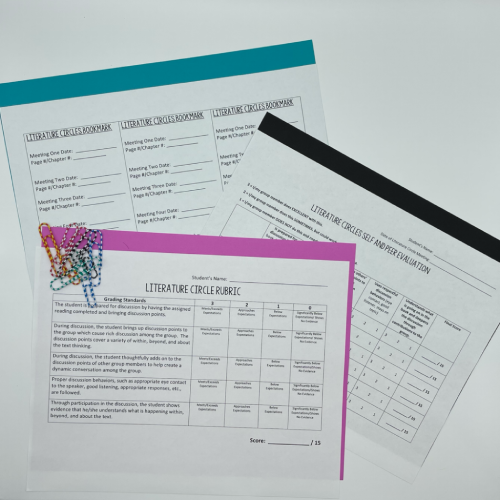One truth I know about middle school students is that they LOVE to talk. Sometimes, this love of talking can hinder the classroom atmosphere. Especially if a teacher has the attitude that the class must be quiet, listen, and be on task the entire class period. I implemented one tiny thing this school year that has revolutionized my classroom behavior as well as my students’ ability to talk about text. I intentionally build in a 3-10 minute chunk of time during the class period for students to discuss our interactive read aloud with one another. Do I read the book out loud and then say, “Okay students, now turn and talk about it.” No, I don’t. Middle school students need a high level of scaffolding at the beginning of the school year to model and structure productive talk. So how did I build in this talking piece?
Post-It Note Discussion
I ask students to grab one Post-It note and think about what I’m asking them to focus on in the read aloud for that given day. I want students to listen and soak up the reading, not be writing and taking notes the entire time. That’s why I choose a Post-It note and not a piece of paper or even a note card. I want them to jot down quick thinking in note form to be used in their group discussion right after the read aloud. I’ve found that starting the year off with giving them one thing to focus in on has dramatically improved my read aloud time. We started off this school year with the read aloud, The Tiger Rising by Kate DiCamillo.
So what are some things that I asked them to jot down on their Post-It note each day?
-Concentrate in on the author’s language and write down one example of figurative language and how that helped you visualize that part of the story.
-Pay attention to what Sistine says in dialogue today. How does what she says impact Rob’s feelings?
-Write down details about the setting. What do we know about where this book takes place? What would we still like to know?
-Make a T-Chart on your Post-It Note. On one side write down a decision you like that the author makes. On the other side write down a decision that you dislike that the author makes.
-As I’m reading today, write down a question you would like to discuss with your small group.
-As I’m reading today, I will stop several times. When I stop, jot down a question, comment, observation, or quote that sticks with you from the text.
-Do any of the characters remind you of a character you’ve read about in a different book? Write down one similarity as we read today.
During read aloud, I let students travel to a comfy place in the classroom with their Post-It note, listen to the book, and fill out their Post-It note. After the read aloud, I ask students to come back to their small groups, and I put up 3-4 focus questions for discussion for that day. The first question is always the same question they focused on when writing on their Post-It note. We developed norms for this time: Talk until the timer goes off, stay focused on the book, look at the person in your group who is talking, select a discussion leader every day to ask the new question once you’re group is done discussing the previous question question listed on the Smartboard. I also tell my students that it’s not essential to discuss every question. If they spend the entire time getting into a great discussion about the first question, that is fine by me. I set the timer for 3-4 minutes, and once it goes off, I ask students to think about if they followed the norms that we set. The first few days we tried this, it was rough. Some groups rocked it, while others weren’t able to get a conversation started, while others were completely off task. I stayed persistent with this practice though and continued to have students use the Post-It note and do a mental self-evaluation after the discussion. The discussion time quickly transformed into intense text talk. It is also an awesome way to prepare your students for literature circles.
The Post-It note centers the conversation and gives students who are shy the out to begin the discussion by simply reading what they wrote down on their Post-It note. One other aspect I’m amazed with is the questions students are forming to ask each other about the text. I have found myself walking around listening in on conversations and getting completely sucked into a group’s conversation. You can never beat an activity that allows students to authentically talk about text. This doesn’t happen though if you don’t model, set norms, and have students constantly self-evaluate. It also helps to have an engaging read aloud that serves as the common text students are discussing. Don’t fear giving students freedom and time to talk!
The Write Around
The write around is an activity that I like to use to get kids “talking” through written communication with one another about text. It’s a quick way for me to see who is capable of communicating their thinking about reading clearly through writing, and who needs more work. This is also a great activity for students who are shy and don’t get their voices heard very often.
Step One: Put students into groups of four. I have students’ desks in quads, so I have them work with the classmates in their desk groupings. Have all students get out a piece of loose leaf paper.
Step Two: Have each student in the group take out a writing utensil that will show up differently on paper. (Example: red pen, black pen, pencil, and green pen)
Step Three: Select four “juicy” questions that students are going to be excited to write about from the portion of text you read aloud to students that day from the class interactive read aloud. Project these questions for all students to see. Number students off by 4 and ask each student to copy down the number that correlates with the number they were given onto the top of their blank sheet of loose leaf paper.
Step Four: Have students start by responding for 2 minutes to their own question. Once the timer goes off, tell students to pass their discussion question to the right. Encourage students to read not only the question, but what the student(s) prior to them wrote down. Increase the time you allow students to write by 30 seconds each time to allow time for students to read the previous written responses and process how they are going to add new thinking onto what has already been written. I tell students to make it conversational and talk about how they agree/disagree with what another classmate in their group has written down.
Step Five: After the papers have been passed all of the way around the group and students get their original question back, have students read all of the responses from the whole group.
Step Six: Allow students time to debrief the learning situation and share reading responses out with their group and eventually the whole class. Below is the Smartboard slide I used to debrief this activity, and it caused great discussion.
Spitball Discussion
This an awesome culminating activity to do with students after the completion of an interactive read aloud. This whole class discussion can add finality and enrichment to the end of a book while students learn listening and public speaking skills.
Step One: Read a section of the interactive read aloud to students. As you’re reading out loud, ask students to write down one creative discussion question that will cause other students to think deeply about the book on a sticky note.
Step Two: After you have completed reading the text, instruct students to crumple up their sticky note, place it in a designated bin in the middle of the room, and get into a whole-class circle on the perimeter of the classroom.
Step Three: Take out a throwable talking piece (I have a squishy ball) and toss it to the student who will begin the discussion activity. The student with the ball will go to the middle of the room, grab a crumpled question, open it, read the question out loud to the class, and then answer the question for the class. Finally, that student would throw the talking piece (squishy ball) to a new student in the classroom. This student would repeat the process.
Step Four: Continue this process until all students have had a chance to answer one of the questions. If the same question is asked, ask the student to provide a different perspective on the question. It a student writes a statement instead of a question, ask the designated student how they could turn the statement into a question. If a student doesn’t know how to best answer the question, they can pass the ball for an “assist.” This is only a last resort though.
As teachers with crazy, busy lives, life sometimes traps you into patterns of what has always been comfortable, easy, or safe. Giving students a chance to talk about text without the teacher being at the forefront may seem unnatural, but we must commit to giving students this time. Futhermore, instead of trying it once and stopping, commit to making it work in your classroom through a variety of discussion activities, modeling of proper behavior, and having students self-evaluate their behavior to see if they’re following classroom expectations. Talking about a book makes that book sink into the child’s heart and have information engraved into their brain. Don’t substitute meaningless worksheets and full teacher-controlled discussion. Take a chance and let students drive the discussion. I guarantee they’ll surprise you.








